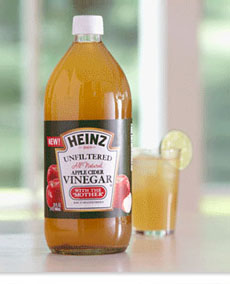TIP OF THE DAY: Match Your Vinegar To Your Food
 Apple cider vinegar is a versatile favorite. Photo courtesy Heinz. |
Vinegar begins life as alcohol. Through fermentation, alcohol is converted to full-strength vinegar, which is then diluted with water to achieve a 5% acidity level for cooking and table use. (Here’s the history of vinegar and how it is made.)
How many different types of vinegar are in your pantry? Heinz, America’s vinegar king, describes the most common varieties and how to match them with different foods: Apple Cider Vinegar: Made from apple cider, it’s ideal for salads, marinades and recipes. It is also used for canning and pickling. Balsamic Vinegar: Sweet and tart with fruity undertones and much less acidity than other vinegars, balsamic is excellent on salads, in sauces and gravies, with meats or with fresh fruits. |
|
|
Distilled White Vinegar: Made from corn and water, white vinegar has a clean, crisp flavor ideal. Personally, we prefer any other vinegar in recipes. But no-flavor-added white vinegar is a great all-natural helper for cleaning and other household uses. Garlic Wine Vinegar: Typically produced from red wine, it’s subtly seasoned with garlic. Try it with antipastos, cold meats, salads and marinades. Malt Vinegar: This English favorite is manufactured from malt syrup that has been fermented into a malt “beer.” Its pungent, full-bodied flavor makes it particularly popular for seafood dishes (like fish and chips), on meats, in macaroni and bean salads, It’s also used for pickling. Red Wine Vinegar: The most popular of all flavored vinegars, use it for all your favorite salad dressing, sauces, glazes or marinades; with steak; and for pickling. Tarragon Vinegar: a favorite on meats, salads, fish or eggs. |
||
|
VINEGAR TIPS FROM HEINZ
Better Burgers: Add a teaspoon of garlic or tarragon wine vinegar and 1/2 teaspoon of prepared mustard, favorite herb or dry seasoning mix per pound of hamburger. Brighter Coffee: Remove mineral deposits from your coffee pot by filling the reservoir with distilled white vinegar and running through a brew cycle. Rinse thoroughly with two brew cycles of water. (Check with your appliance’s manufacturer’s instructions about the use of vinegar for cleaning.) Cleaner Counters: Use distilled white vinegar to clean your microwave, cutting board and other kitchen areas where you prepare food. It‘s natural alternative to chemical cleaners. Cooking Wine Substitute: When a recipe calls for wine, substitute red wine vinegar, diluting one part vinegar with three parts water. |
 People love balsamic vinegar because it’s complex, sweet, fruity and not acidic. Photo: The Nibble. |
|
|
Fluffier White Rice: Add a teaspoon of white vinegar to the boiling water. Your rice will be easier to spoon out and less sticky. Hard Cooked Eggs: To prevent cracking, add two tablespoons of distilled white vinegar per quart of water before boiling. The shells will peel off more easily, too. Make Buttermilk: When a recipe calls for buttermilk and you don’t have any on hand, just add a tablespoon of distilled white vinegar to a cup of milk. Marinade: A mixture of one-half cup of cider, white or wine vinegar added to a cup of liquid bouillon makes a great marinade base. More Flavorful Fish: You can enhance the flavor of your favorite grilled fish dishes by adding a dash of white vinegar. For firmer, whiter fish, soak your favorite filet or seafood steak for 20 minutes in one quart of water and two tablespoons of vinegar. Odorizer: To remove cooking odors, leave a bowl of distilled white vinegar on the counter while cooking. This works great when cooking fish! Rescue A Recipe: If it tastes too sweet or too salty after you’ve mixed the ingredients, try adding a dash of distilled white vinegar. It may save the day. Revive Vegetables: If raw vegetables look a little tired and wilted, soak them in one quart of cold water and a tablespoon of distilled white vinegar. Find more tips at HeinzVinegar.com, including uses in the bathroom, family room, laundry room and all around the house.
|
||


